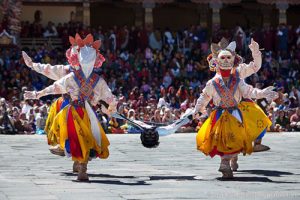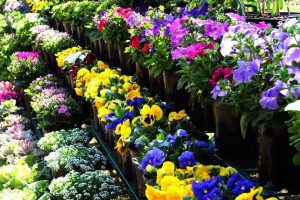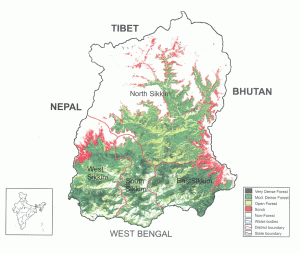Folk Dances of Sikkim
People and Culture of Sikkim
- The People of Sikkim consist of three ethnic groups, that is, Lepcha, Bhutia and Nepali.
- Communities of different hues intermingle freely in Sikkim to constitute a homogenous blend.
- Hindu Temples coexist with Buddhist Monasteries, Churches, Mosque and Gurudwara.
- The predominant Communities are Lepchas, Bhutias and Nepalese.
- These myriad Cultures has produced a quintessential Sikkimese Culture that encompasses all ways and walk of life, but has also managed to preserve their own identity.
- These can also be seen in the various places of Worship, Festivals and Cultural dances that are celebrated through the year.
Various Lepcha Folk Dances
Lepcha Folk Dances
- Through this romantic dance, story of a young boy and a girl in love is conveyed.
- A group of boys ask a group of girls for their hands for the purpose of marriage and in turn promise them with rich gifts and ornaments.
- The girls, however, turn down the offer and ask them to approach their parents, instead.
- This colourful dance is performed with the support of melodious Lepcha songs and musical instruments such as Sanga (drum), Yangjey (string instrument), Cymbal, Yarka, Flute and Tungbuk.
Zo-Mal-Lok Folk Dance of Sikkim
- This famous folk dance of Lepcha community shows normal activities such as sowing, reaping and harvesting of paddy.
- The old people and young folk alike join hands to sing, dance and indulge in merry making.
- The graceful movements of male and female dancers become more noticeable with the background of pleasant sounds of seasonal birds.
- Musical instruments used to support the dance are Tungbuk, Flute, Cymbal, Drum, etc.
Chu-Faat Folk Dance of Sikkim
- Literal meaning of Chu is Snowy Range, while that of Faat is Worship.
- This group folk dance is performed in the honour of Mount Khangchendzonga, the guardian deity of the Sikkimese people.
- The dancers while carrying butter lamps and green bamboo leaves perform a ritualistic dance by singing devotional songs.
Tendong Lo Rum Faat Folk Dance of Sikkim
- It is based on a famous Lepcha folk lore often retold to the new generation of Lepchas in the form of lyrical poetry.
- According to the legend, this group dance is performed to save people from the onslaught of mighty, mountainous rivers, First, the Lepchas living on the Tendong Hill in South Sikkim are reported to have offered prayers to the God through this dance.

- They desired the almighty to save them from the disaster of rising water.
- As per folklore, God came as a bird and began sprinkling sacred millet beer on water.
- Soon, the level of water subsided and people heaved a sigh of relief.
Kinchum-Chu-Bomsa Folk Dance of Sikkim
- This famous folk dance vividly describes the natural beauty of Sikkim, or Ney-Mayel-Lyang (a heavenly, hidden paradise) called so, by the Lepchas.
- The snow covered mountain peaks, green captivating meadows, enchanting valleys, thick vegetation, rivers and water falls, holy lakes and serene monasteries sanctify this land.
- The young Lepcha boys and girls show their attachment with the land by performing the dance in their colourful attire.
Bhutia Folk Dances of Sikkim
Denzong-Neh-Na Folk Dance of Sikkim
- This group dance comprising of boys and girls is performed to pay homage to the past saints such as Guru Rimpoche and present saints in order to get their blessings.
- The musical instruments which support the graceful steps of the dancers are: Flute, Yangjey, Drum and Yarka.
Ta-Shi-Yang-Ku Folk Dance of Sikkim
- A group of boys and girls through this dance try to invoke benign deities to shower fortunes on their home.
- They remember some animal deities also to bring good fortune and prosperity to the people.
- It is also performed during the consecration of a new house and to bless a newly married couple.
Tashi Shabdo Folk Dance of Sikkim
- This age old group dance beautifully and gracefully shows the custom of offering Khadas (scarf) on auspicious occasion.
- The white scarf exchanged by the members of the group during the course of dance is basically a symbol of peace, purity and prosperity.
- The dancers dance to the melodious tunes duly supported by musical instruments such as Yarka, Drum, Flute and Yangjey.
Guru-Chinlap Folk Dance of Sikkim
- Through this particular group dance performed by boys and girls, due respect is shown to the various Buddhist Gurus and Saints of Sikkim and their blessing is requested for overall peace, prosperity and happiness.
- Exchange of Khadas also takes place between the dancers during the course of the dance.
Singhi Chham Folk Dance of Sikkim
- In this group dance five boys led by a herdsman dance like legendary Snowlion.
- The snowlion is a significant cultural symbol of the state.
- The presence of two snowlions dancing under the guidance of a herdsman looks extremely attractive and enchanting to the viewers.
- Musical instruments (without any songs) used are Drum, Cymbal, Yarka and Yangjey.
Yak Chham Folk Dance of Sikkim
- Through this group dance performed by four male dancers under the command of a herdsman, utility of Yak for a common man living in high altitude areas is shown.
- The dance begins in slow and measured steps to the clash of cymbals and the sound of the trumpets.
- The group dance always makes a powerful impact on the audience and appears very attractive to the children.
- Though Chhams are performed in all the monasteries of Sikkim, the ones performed at Pemayangtse, Rumtek and Enchey being more impressive draw large audience.
Nepali Folk Dances of Sikkim
Maruni Folk Dance of Sikkim
- It is one of the oldest and popular group dance forms of the Nepali community, usually performed by three male and three female dancers.
- In good old days, the role of Maruni, essentially a female character, was enacted by a male. With the change in customs and traditions, female dancers are now performing such a central role.
- It is performed during the festival of Tihar in the courtyard of each house.
- The steps of the dancers look very graceful in the background of soothing songs ably supported by musical instruments such as Harmonium, Madal, Flute and Ghoongur.
Chutkay Folk Dance of Sikkim
- Through this romantic group dance, performed by a group of male and female dancers, joys of life and feeling of happiness is shared during the harvesting season and on some other happy occasions.
Dohori Folk Dance of Sikkim
- This group dance of Gurung community is usually performed by three male and three female dancers.
- In a traditional setting, after a hard days work, the dancers would assemble at ‘RodiGhar’ (a sort of entertainment centre) and exchange their views through songs and dance.
- The musical instruments used are Madat Flute and Ghoongur.
Jeurum Silly Folk Dance of Sikkim
- By means of this group dance of Rai community, performed by one man and four women, feelings of family members and friends is expressed on the occasion of a girl’s marriage.
- The dancers aim to protect the Lakshmi (prosperity) of the house. Youth and old alike also join the dancers.
- Dhol and Jhamta are the two musical instruments used.
Tamang Selo Folk Dance of Sikkim
- This group dance of Tamang community with robust foot tapping and elaborate sound and display of Damphu instrument is performed on all happy occasions.
- It highlights vigour and vitality of the community.
- Tamang songs known as ‘ Hwai’ are full of human emotions.
- These are so popular that no Nepali merrymaking is considered complete without singing a Tamang song.
Lakhey (Mask) Dance Folk Dances of Sikkim
- This group mask dance of Newar (Pradhan) community is performed to ward off evil spirits and to bring peace and prosperity.
- The musical instruments which support the dance form are Khe( Dhol), Jhali and Dhimay.
Naumati Folk Dance of Sikkim
- In this beautiful group dance of Damai community nine kinds of musical instruments are used to perfection.
- These are two types of Senai ( Shehnai), Turhi, small and big, Damaha (Nagara) of two types, Tuyamko (Small Dhol) of two types, Dholki and Jhyamta (cymbal).
- The Naumati Baja is a regular feature during the wedding and other auspicious occasions.
Chyap-Brung Folk Dance of Sikkim
- Chyap-Brung is the traditional musical instrument of the Limboo community.
- It is like a Dholak in shape but much bigger in size.
- During the course of group dance, male dancers hang the instrument around their necks with the help of a rope and beat the drum with an open palm on one side and a stick on the other.
- Such a manoeuvre produces two different sounds which echo boldly in valleys and mountains.
Dhaan Nach Folk Dance of Sikkim
- This group dance performed by four men and four women with the backing of harmonium, madal, flute and ghoongur shows the symbol of good and firm spirit of farmers against rain and scorching heat.
- In order to break the monotony of routine field work, men and women attempt merrymaking through song and dance.
- It is a ritualistic dance performed by the youth and old alike in traditional costumes, since time immemorial.

